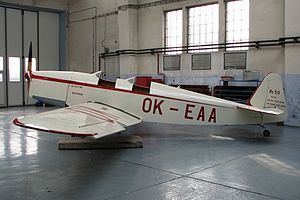Top speed 205 km/h Length 7.76 m Designer Pavel Beneš | Wingspan 11 m | |
 | ||
The Beneš-Mráz Be-50 Beta-Minor was a light airplane manufactured in Czechoslovakia shortly before World War II.
Contents
Design and development
First flown in 1935, it was a low-wing cantilever monoplane of wooden construction, with tandem open cockpits and fixed tailwheel undercarriage. The aircraft proved popular with Czechoslovakia's aeroclubs and was successful in international competitions. In 1937, the designers created a modernised version, the Be-51, which featured a reduced wingspan and fully enclosed cockpits. A final variant, the Be-52 Beta-Major retained the Be-50's open cockpits but featured improved aerodynamics and a more powerful Walter Major engine.
Operational history
Like other Czechoslovakian aircraft, all available machines were impressed into Air Force service at the outbreak of war. Several Be-51s survived to be used by the Luftwaffe as liaison aircraft and trainers during the occupation.
Variants
Operators
Specifications (Be-51 Beta-Minor)
Data from
General characteristics
Performance
